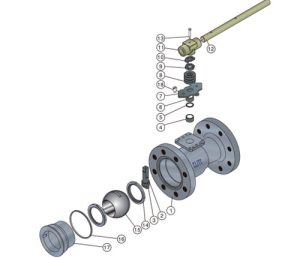In a floating ball valve, the ball is held in place by two elastomeric seats. Between these seats, the ball is able to “float” inside the valve’s body.
The valve stem is connected to a slot in the top of the ball. This allows the ball to rotate one-quarter turn, or 90 degrees.
The valve shaft allows for a limited amount of lateral movement for the ball, which is generated from upstream pressure against the ball. This lateral movement, though small, drops a load upon the ball great enough to press the ball against the downstream seat. This improves tightness to avoid leaks.
This kind of ball valve is capable of bidirectional shutoff. However, a floating ball valve is hard to operate when the upstream pressure is very high. To combat this problem, the mounted ball valve is used instead.

